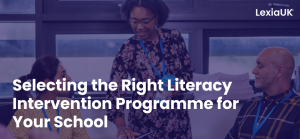Choosing the right literacy intervention programme is a crucial decision for school leaders looking to improve student outcomes. With so many options available, it can be overwhelming to know where to start. This post will offer practical advice on selecting an effective programme, including how to evaluate claims, consider evidence, and ensure the programme meets the diverse needs of your students. We will also discuss the value of trying out a programme in your own school environment and connecting with peers in similar settings.

1. Above All Else, Start with the Evidence
When evaluating a literacy intervention programme, it’s essential to look beyond the provider’s marketing claims and focus on the robustness of their collected evidence. While some providers may boast impressive results, school leaders should critically assess the quality and reliability of the research underpinning these claims. For instance, the findings from a small-scale pilot involving only a handful of children are inherently less reliable than those from a large-scale, multi-school study where hundreds of children are divided into carefully matched control and treatment groups. To assist schools with navigating these complexities, the Education Endowment Foundation (EEF) provides independent and maintains a “Promising Programmes” list, highlighting thoroughly researched, evidence-based interventions. This list can offer schools a practical starting point from where to begin their selection process.
Key factors to consider include:
- Has the programme been independently evaluated for its effectiveness?
- Does it show measurable improvements in literacy outcomes?
- How well does it align with your school’s priorities and challenges?
Be cautious of programmes that make broad claims without clear, evidence-backed results, and ensure that the programme fits the unique needs of your students.
2. Ensure the Programme Meets Multiple Needs
Each pupils’ literacy needs are unique and the programme you choose should be able to address a broad range of student needs. Consider a programme that can support not only struggling readers but also those who are ready for additional challenges. Over time the needs of your students will change and the program you choose should be broad enough to support them beyond the ‘catch-up’ stage.
Look for features that allow the programme to be flexible in addressing various aspects of literacy, including phonics, comprehension, vocabulary, and fluency. It should also be adaptable for different learning styles and levels, ensuring that all students receive the essential support they need.
A good literacy programme should also consider the diverse needs of students, including those with learning difficulties or English as an additional language. Ensuring that the programme is comprehensive and differentiated will lead to better outcomes for a wider range of learners.
3. Test the Programme in Your Own School Environment
Before committing to a literacy programme, it’s crucial to evaluate how well it works in the context of your own school. This includes assessing how easily the programme can be integrated into your existing curriculum and teaching methods.
A hands-on trial period can provide invaluable insights into how the software works in practice. Used alongside published evidence, this trial period allows you to see first-hand how the programme functions in a real classroom setting, how students engage with it, and how teachers find its ease of use and effectiveness.
During the trial, it’s also important to assess the support and resources available to your teaching staff, as training and professional development will be vital to successful implementation. This will also give you a clearer idea of the programme’s long-term viability in your school.
4. Speak to Similar Schools and Users
One of the best ways to assess the effectiveness of a literacy programme is by talking to other schools that have used it. Reach out to schools with similar challenges or demographics and ask about their experiences with the programme. A potential provider should be able to put you in touch with a school who can give you a personal and independent view.
Peer feedback is invaluable in understanding the practical implications of using a specific programme. Schools that have seen positive results can offer insights into how the programme has helped their learners and the support they received during implementation.
Many programme providers will also offer case studies or testimonials from schools that have used the product successfully. Engaging with these resources can provide a clearer picture of how well the programme could work in your own setting.
Other sources of school feedback can be obtained from educational review sites such as EdTech Impact. Here you can search possible solutions and read independent educator reviews.
5. Ensure Ongoing Support and Training
A successful literacy programme doesn’t end after the initial implementation – it requires ongoing support and professional development to ensure long-term impact. When evaluating programmes, remember to thoroughly research this often-overlooked aspect of the selection process.
Ask providers specific questions about how they handle ongoing support. For instance, do they have a dedicated team of trainers? If not, how will support be delivered, and are there additional costs involved? Look for programmes that offer regular training, continuously updated resources, and accessible support channels to help teachers implement and refine their approach. This commitment to ongoing implementation ensures your staff feel confident using the programme, so that pupils continue to benefit from it.
Conclusion
Selecting the right literacy intervention programme is a critical decision for your school, and it’s essential to choose one backed by solid evidence, flexibility, and ongoing support. At LexiaUK, we are committed to helping schools transform literacy outcomes through our adaptive, evidence-based programmes. With a focus on empowering both students and educators, our solutions are designed to meet the diverse needs of all learners. Like thousands of schools from across the UK, start your Lexia journey with a 30-day free evaluation of our programme today and see how we can help unlock every student’s reading potential.
